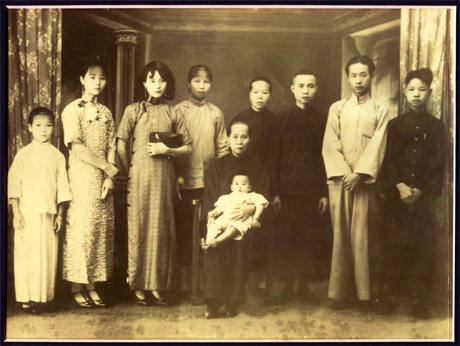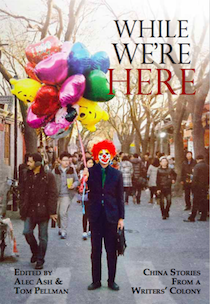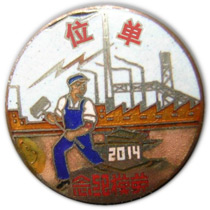Searching for Home
Family footsteps retraced – by Peta Rush

It’s Chinese new year, which means auspicious red paper decorations and lanterns are being hung up, and fireworks can be heard going off every evening. For those who live away from their laojia, or ancestral home, it also means taking the bus, train or plane in the largest annual human migration in history, as people return to their family homes for the holidays.
I might do the same, if I knew where mine was.
The laojia is an important and well defined concept in Chinese culture. It represents your family’s place of origin, and is still significant in today’s society. Migrant workers will usually make the effort to return home every year for the Spring Festival, even if that means a 30 hour crowded train journey halfway across the country. At university, students from the same region often become members of a hometown society, to stave off homesickness.
One of the main reasons why I came to China was to discover my own laojia. I grew up in Singapore before moving to England when I was seven, and am “mixed blood” (hunxue’er). My father is English but my mother, although born and brought up in Singapore, was ethnically Chinese. Along with many others, her ancestors fled China during the communist insurgency of 1927-1937, when the Nationalists and Communists were vying for control of the country. Some of the family went to Indonesia and Hong Kong, others remained behind in China, but my maternal grandparents settled in Singapore. There they raised their four children in a humble kampong, a settlement of very basic village housing.
In the early 1970s, when my mother was growing up, Singapore wasn’t the booming financial city it is today. But even by the standards of the time, my mother’s upbringing was a tough one. She once told me of her acute embarrassment when, at her primary school’s annual medical check, she had to wait in line in her home-made underwear while her classmates wore shop-bought knickers with proper elastic.
At home, they would mostly eat rice, bulked out with pickled vegetables. My mother said she was able to eat four bowls of rice for dinner, despite remaining beanpole thin. Their fruit and vegetables were usually the half rotten kind that are sold at discount at markets, which today’s generation would disdain. As a child, my mother only once ate “perfect” fruit – when she was ill, a family friend brought her a whole bunch of grapes. I still remember getting an earful as a child when I tried to throw away a half rotten apple.
Then there was the chicken they kept in the bathroom, and fed with scraps from the family table before slaughtering it for the Chinese new year reunion dinner (tuanyuanfan). This was repeated each year with a new “toilet chicken”, and my mother as a child was torn between sympathy for their pet and excitement about eating chicken meat.
My grandparents came from far less humble origins, but by all accounts were not particularly loving or warm parents to my mother. My grandfather (or gonggong) was originally from a wealthy landowning family in Guangzhou province – which was the main reason why they fled China when the Communist party was on the rise in the 1930s. The family had seven children in total, including my gonggong, although one of them died as a child. According to my mother, that daughter was accidentally given rat poison instead of cough medicine, both of which were kept on the same shelf in the kitchen.
My grandmother had one elder sister, who was married off as the second wife to a wealthy, much older man. When my great aunt (yipoh) was a child, it was still the custom in China to bind girls’ feet. This was an extremely painful ritual where the bones of a young girl’s feet were broke, then bound tightly with bandages so they could not properly heal, leaving the desired “lotus feet”.
When my great grandmother tried to bind my great aunt’s feet, yipoh screamed so much that after a few months her mother finally relented and took the bandages off. Her feet were allowed to grow, but she had difficulty walking for the rest of her life. I remember visiting her many times as a child, bringing her crates of duty free cigarettes from England and enduring the customary cheek pinch bestowed by Chinese elders on every child. Despite smoking 60 cigarettes a day, she long outlived my grandmother, and lived a comfortable life in the large Singapore apartment left to her by her late husband.
My grandmother died when I was only one month old. The only memories I have of her are from my mother’s stories. She and my grandfather married in their teens, and she too was set up comfortably. But my grandfather was a favoured and spoilt son, and his newfound independence in Singapore allowed him to indulge his gambling habit. He lost most of their savings early on in their marriage, and his family soon stopped sending him money. He found work as a ship’s carpenter, and started to live a more honest life. My family still has a beautiful wooden chest which was made by him. He eventually died of throat cancer, after inhaling fumes from the tar which he used to coat the decks of the ships, to help them withstand sea water.
When my grandfather was away at sea, my grandmother spent her time playing mahjong. My mother would often come home from school to a dark house, unable to turn on the lights as she was too small to reach the switch. She would weigh up the odds of going to find her mother. If mahjong was going well, she would get a dollar with which to go and buy herself some noodles for dinner. If her mother was doing badly, though, she would receive a smack and no money for food. She often went to bed hungry, or had to turn to her oldest brother, who had already left school to work. He would give my mother pocket money, and was the main reason she could complete her schooling.
My mother died while I was still at school, and many parts of her and my grandparents’ story are missing. Back then I didn’t have much interest in my Chinese heritage – I was more concerned with being as Western as possible. I do, however, remember my mother talking about travelling to China with me. I suspect now that she was thinking of visiting our laojia.
Now that she is gone, and my connection with China is fading, it’s more important to me than ever to find a link with that side of my family. As hunxue’er go I look pretty Western, which has never bothered me in the past, but now I’m in China I find myself rather desperately clinging to my Chinese side. I go out of my way to convince colleagues and friends that I really am half Chinese, but I suspect many of them still don’t believe me. If you’re half Chinese, they ask me, why can’t you speak Chinese fluently?
I remember a conversation with my older brother about the confusion we both feel whenever someone asks where we are from. As a mixed-race migrant, the options are greater than most. Do they want to know where we lived for most of our childhood, or why we look “different”? Are they asking where we were born, or where we live now? Or are they really asking where our father is from?
In returning to my laojia, the village where my grandparents were born, part of me thinks I will finally find somewhere I properly belong. By retracing the steps my family took all those years ago, I might have a better understanding of where I come from and who I am. I might even find someone who remembers the young couple who set out for Singapore, and who can fill in the many gaps in my story.
But it isn’t easy to find my ancestral home. First, I don’t remember the name of the village. All I know is that it was near a river and that they spoke Seiyap, a regional dialect of Cantonese – which narrows it down to the greater Taishan area in Guangzhou province. With a population of roughly four million, that isn’t a great start.
Second, I don’t know exactly what my grandparents’ names were. Chinese children traditionally address relatives according to their relation to you. As a child I used to introduce my brother to friends as gohgoh, or “older brother” in Cantonese. I thought that was his name. My grandparents were always gongong and pohpoh, and I never thought to ask what they were actually called. Because Singapore was under British rule at the time, my mother's birth certificate is of no use either – all official records were kept in English. Her surname is recorded as “Kong”, a phonetic version of the Cantonese pronunciation. I don’t even know which character it is: 孔 or 空.
And last, because of the upheaval of war, the Mao era and China’s current rate of development, I doubt that anything would remain of my ancestral house even if I were to find the village. As landowners, my grandparents’ property would probably have been ransacked by the Red Guards, with anything of worth looted or destroyed. And even if it is still standing, all I have is a decaying photograph of the main room. Unless I happen across someone who remembers the people in the picture, my chances of finding the house are almost impossibly slim.
Faced with the enormity of the task, I have been thinking about the concept of laojia, and whether finding mine would really give me any deeper knowledge about myself and my background. In her book Factory Girls, the journalist Leslie Chang describes visiting her ancestral home for the first time. “A family is not a piece of land,” she writes. “It is the people who belong to it, and it is the events that shape their lives.”
In the same way, my search for my own laojia has been more about threading together the narrative of my family’s past, to help me understand how I come to be where I am today. The physical location itself isn’t where my family can be found. My family exists in the stories that were passed down from my grandparents to my mother to me. It is these stories that prompted me to return to China to study Mandarin in Chengdu, and to find out as much about my family as possible, so that their heritage does not end with me. Perhaps that is what the idea of laojia really embodies in today’s changing world.

This is the only picture I have of my mother's family in Guangzhou. My grandmother is standing second from the left, with my great aunt next to her, third from the left. Seated in the front row is my great grandmother
•
Peta Rush is a student and teacher living in Chengdu

















